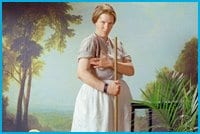
Peter Kingstone. Gallery TPW.
The case of Hannah Cullwick is bizarre, to put it mildly. She was a Victorian-era maid-for-hire from Shropshire who kept a diary (that she could read or write is already exceptional, given her class) and was an amateur photographer. She wasn’t interested in taking picturesque snaps of the English countryside; she was too busy chronicling the lifelong SM relationship she had with solicitor and poet Arthur Munby.
Munby was a proto trade- and dinge-queen: He had a fetish for large working-class women, preferably covered in a day’s filth. At one point he met Cullwick, who became his maid and later his secret wife (although even when married, she insisted on remaining his maid). Both of them kept diaries of this exceptional relationship, and Cullwick created a series of photographs — tableaux chronicling their mutual fetishes, proudly displaying the signifiers of their life together. For the entirety of their relationship, Cullwick wore a lock and chain around her neck (to which Munby had the key) and a leather slave-band around her right arm. She died in 1909 at the age of 76.
German curator Pauline Boudry and Swiss artist Renate Lorenz have made an extraordinary exhibition in response to this extraordinary woman. Normal Work at Gallery 44 is one of the feature exhibitions of this year’s Contact photography festival. Lorenz and Boudry came across this treasure trove by accident. “We were reading a book by Anne McLintock, Imperial Leather, and she wrote two paragraphs on the photographs [of Cullwick],” says Boudry. “We didn’t even read it — we saw the pictures and we thought, ‘Wow, this is so amazing.'” The pair then went to Trinity College, Cambridge where the diaries and photographs are kept as part of Munby’s archive. “We noticed that there had been no queer perspective on their relationship and on the photographs. So something that interested us was to research her, and try and suggest another kind of perspective.”
In her video Boudry has Werner Hirsch, a Berlin-based drag performer, reenact four different Cullwick photographs: “One of her as a maid, where she shows her muscles — and it’s a very impressive photograph because you can see the slave-band,” say Boudry. “The second photograph is of her as a gentleman; the third is her as a maid-slave; and the fourth is one of her as a lady. Hannah Cullwick did all these different drags — gender drag, ethnic drag, class drag — and we were really interested in the different positions that she stages.”
So while the queerness in these photographs isn’t anything you could make a Pride flag out of, it’s certainly there, if subtly. If Munby was a trade queen then Cullwick was a classic butch. She took great pride in her work and the masculine bearing it endowed her with. “Cullwick and Munby definitely had fetishes,” says Boudry, “but they were always chosen to function in a double way. They could always function in the register of work and the register of sexuality at the same time — coarse hands, that are a sign of work, but are also very sexual. The muscles function in the same way. She has large muscles, which is a sign of hard work, but also of masculinity.” In fact the most difficult aspect of their relationship, for Cullwick, was her having to fulfill any genteel duties. When they vacationed together or entertained guests, for instance, Cullwick would have to doll herself up in femme drag and act as an upper-class lady so as not to arouse suspicion and class scandal. She hated this, as she hated the trappings of typical Victorian feminity: gentility, passivity, etiquette. It’s not a difficult stretch to reclaim Cullwick as a feminist.
Boudry and Lorenz are also interested in reclaiming Cullwick as an artist. In their research they saw something missing. “We also noticed that nobody had exhibited the photographs in an art context,” says Boudry. “So it was interesting for us to put her pictures in an art context to allow an audience to look at her work as a cultural producer, as somebody who is very exacting when dealing with the different images she produced.” To contextualize Cullwick, Boudry and Lorenz position her against other photographers. In the video, the photo-reenactments take place against two different back-projections: the pastoral hobby photographs of Cullwick’s contemporaries and the recent dragged up leather-dyke photographs by US genderqueer artist Del La Grace Volcano.
But whatever reclamations Boudry and Lorenz make the one thing that is absolutely certain was Cullwick’s exceptional (given the era and her class) degree of control over her life and circumstances. Alongside these reenactments and juxtapositions, Boudry and Lorenz excerpt her diary. For Boudry, that inclusion is strictly necessary. “I think the background information with the diaries is important because you see how much agency she had doing the pictures and in the relationship.” Boudry’s video reference this degree of control by having Wirsch directly address the camera. “Our performer is not just passive, sometimes he’s asking things of the director,” says Boudry. “There is this third element, which is a mirror. So the performer sometimes looks at himself in the mirror and checks his image to see if it’s correct. So it’s interesting for us that the performer has that kind of control in the scene because he can adjust his image.”
Ultimately, Cullwick was a profoundly complex woman who saw nothing bizarre about the contradictions of her life: headstrong and independent, with a fetish for domestic work and slavery. Still, she maintained control throughout. She set the permissions and the limits of her relationship with Munby (never mind that her relationship involved literally licking his boots). And Boudry and Lorenz have honoured this woman by creating an equally complex and layered portrait of her.
The opening reception is Sat, May 10 from 2pm to 5pm.

 Why you can trust Xtra
Why you can trust Xtra


